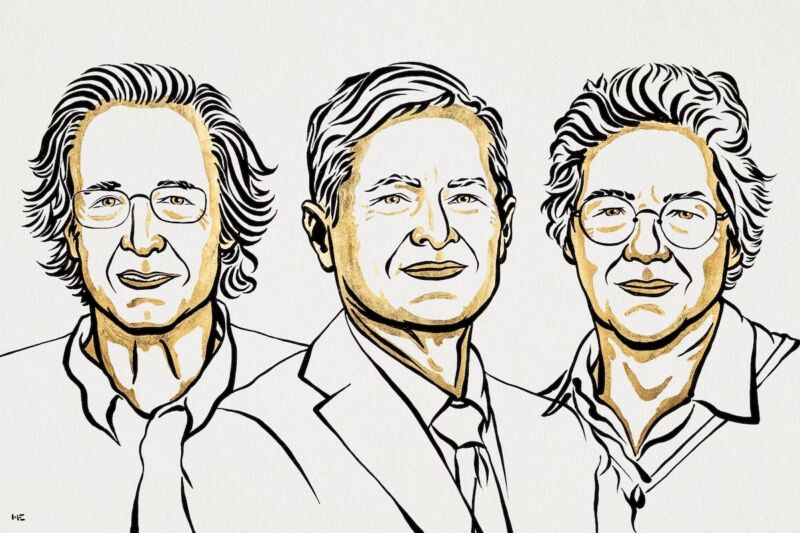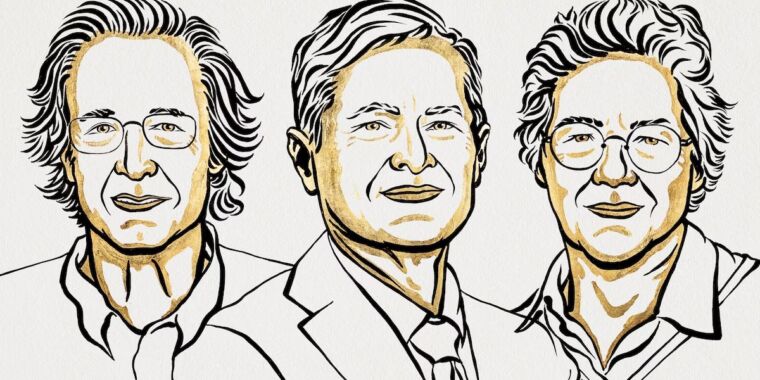
Niklas Elmehed/Nobel Prize Outreach
Electrons move and change energies at such a blistering speed that physicists long believed it would never be possible to capture their dynamics, even with the fastest lasers. The Royal Swedish Academy of Sciences has awarded the 2023 Nobel Prize in Physics to three scientists who used ultrafast pulses of light to do just that with a technique known as attosecond spectroscopy. Per the citation, Pierre Agostini, Ferenc Krausz, and Anne L’Huillier “have given humanity new tools for exploring the world of electrons inside atoms.”
It’s well known that to capture detailed images of, say, a hummingbird mid-flight, one needs to use exposure times that are shorter than a single beat of the hummingbird’s wings. But atoms in a molecule move in billionths of a second, aka femtoseconds; electrons move and change energies faster, between one and a few hundred attoseconds. (An attosecond is one billionth of a billionth of a second.) If you sent a flash of light from one end of a room to the other, it would take 10 billion attoseconds. Physicists had long believed that a femtosecond was the fundamental limit for producing short bursts of light—at least with existing technology—and thus capturing the behavior of electrons in atoms was beyond reach.
That changed over the last 20 years. “The ability to generate attoseconds of light has opened the door on an extremely tiny timescale, and it also opened the door to the world of electrons,” said Eva Olsson, chair of the Nobel committee for physics, at the press conference announcing the prize. “Back in 1925, Werner Heisenberg argued that this world cannot be seen. Thanks to attosecond physics, this is now starting to change.” The work is expected to have a significant impact on electronics, where understanding and controlling how electrons behave in materials is critical to achieving faster electronics, as well as in medical diagnostics, which requires being able to identify different molecules.

Johan Jarnestad/The Royal Swedish Academy of Sciences
The scientific foundation for this year’s prize arose from L’Huillier’s 1987 experiments transmitting infrared laser light through a noble gas. Any kind of waveform can be constructed by combining various waves of the right sizes, wavelengths, and amplitudes; to get a waveform capable of capturing an electron’s movements on an atomic scale, one needs to combine lots of very short wavelengths. It’s impossible to do this with just a laser, but L’Huillier’s lab discovered that passing the laser light through a gas will lead to interactions with the atoms in the gas.
This results in overtones, akin to the overtones of sound waves produced by a guitar or piano. The overtones then interact with each other, and under just the right circumstances, those overtones can be “in phase”—that is, the peaks of their waves line up in such a way that they reinforce each other, making the laser light more intense and producing pulses just a few hundred attoseconds long.
Now at Lund University in Sweden, L’Huillier is only the fifth woman to receive the Nobel Prize in Physics in the Academy’s 122-year history of awarding it. She was lecturing to students when her phone kept ringing; eventually, she answered to hear the life-changing news—and then kept right on teaching. (Students and colleagues at Lund lined up to cheer for the newly minted laureate afterward.) “The last half hour of my lecture was difficult to do,” she said during the Nobel news conference. “I am very touched at the moment. As you know there are not so many women who get this prize, so it’s very, very special.”








